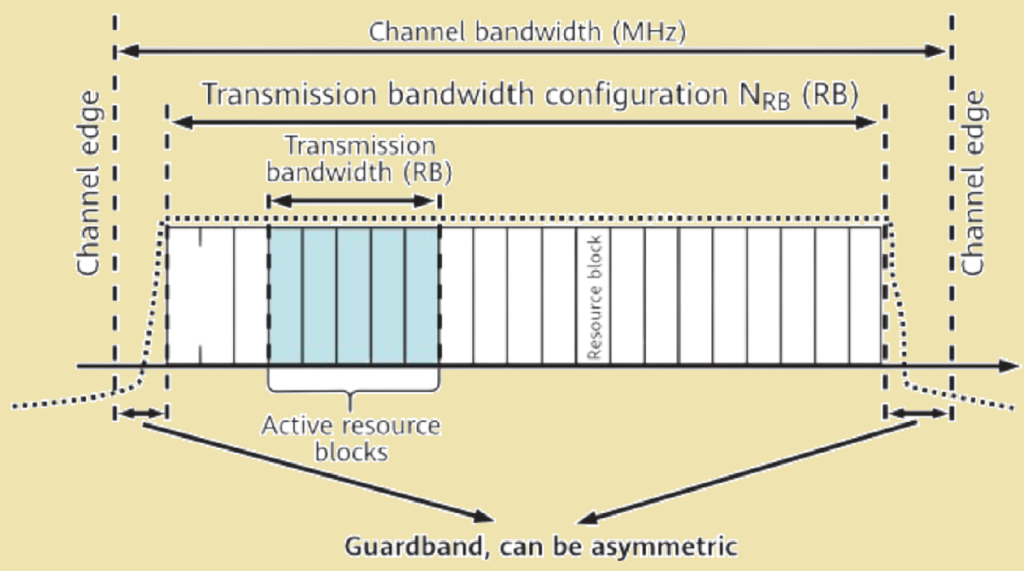As mentioned in 5G frequency band division, the entire spectrum resource is divided into several frequency bands. Division of these frequency bands is based on the current spectrum resource usage and future planning in each country. As such, the spectrum ranges of certain frequency bands can sometimes overlap. In terms of a wireless communications system, if we think of a channel as a highway, the width of the highway must meet at least one standard, and this standard width represents the standard channel bandwidth, or carrier bandwidth.
Like LTE, 5G NR does not use all the spectrum resources of a standard channel bandwidth for data transmission, as some on the left and right sides are reserved as guard bands to avoid out-band interference during transmission. The available spectrum resources for data transmission are referred to as the transmission bandwidth. As such, spectrum utilization of a standard channel bandwidth is calculated by dividing the maximum transmission bandwidth by the channel bandwidth. Figure below shows the relationship between the channel bandwidth, transmission bandwidth, and guard bandwidth.
Figure below Channel bandwidth, transmission bandwidth, and guard bandwidth.

In an LTE system, the proportion of the maximum transmission bandwidth to a standard channel bandwidth is fixed to 90%, which means that 10% of channel bandwidth is always used as the guard bandwidth. In 5G NR, the filtered-orthogonal frequency division multiplexing (F-OFDM) modulation scheme is used. Consequently, the maximum proportion of spectrum resources used for data transmission varies with SCSs and channel bandwidths. 3GPP TS 38.104 defines the channel bandwidths and corresponding maximum transmission bandwidth proportions, as listed in Table 1, Table 2, Table 3, and Table 4. Compared with LTE, 5G NR does not define standard channel bandwidths smaller than 5 MHz.
Table 1. Channel bandwidths and transmission bandwidth proportions supported by FR1 (SCS = 15 kHz)
| SCS (kHz) | Channel Bandwidth (MHz) | Maximum Number of RBs | Transmission Bandwidth Proportion |
|---|---|---|---|
| 15 | 5 | 25 | 90% |
| 10 | 52 | 93.6% | |
| 15 | 79 | 94.8% | |
| 20 | 106 | 95.4% | |
| 25 | 133 | 95.8% | |
| 30 | 160 | 96% | |
| 40 | 216 | 97.2% | |
| 50 | 270 | 97.2% |
Table 2. Channel bandwidths and transmission bandwidth proportions supported by FR1 (SCS = 30 kHz).
| SCS (kHz) | Channel Bandwidth (MHz) | Maximum Number of RBs | Transmission Bandwidth Proportion |
|---|---|---|---|
| 30 | 5 | 11 | 79.2% |
| 10 | 24 | 86.4% | |
| 15 | 38 | 91.2% | |
| 20 | 51 | 91.8% | |
| 25 | 65 | 93.6% | |
| 30 | 78 | 93.6% | |
| 40 | 106 | 95.4% | |
| 50 | 133 | 95.8% | |
| 60 | 162 | 97.2% | |
| 70 | 189 | 97.2% | |
| 80 | 217 | 97.7% | |
| 90 | 245 | 98% | |
| 100 | 273 | 98.3% |
Table 3. Channel bandwidths and transmission bandwidth proportions supported by FR1 (SCS = 60 kHz).
| SCS (kHz) | Channel Bandwidth (MHz) | Maximum Number of RBs | Transmission Bandwidth Proportion |
|---|---|---|---|
| 60 | 10 | 11 | 79.2% |
| 15 | 18 | 86.4% | |
| 20 | 24 | 86.4% | |
| 25 | 31 | 89.3% | |
| 30 | 38 | 91.2% | |
| 40 | 51 | 91.8% | |
| 50 | 65 | 93.6% | |
| 60 | 79 | 94.8% | |
| 70 | 93 | 95.7% | |
| 80 | 107 | 96.3% | |
| 90 | 121 | 96.8% | |
| 100 | 135 | 97.2% |
Table 4. Channel bandwidths and transmission bandwidth proportions supported by FR2.
| SCS (kHz) | Channel Bandwidth (MHz) | Maximum Number of RBs | Transmission Bandwidth Proportion |
|---|---|---|---|
| 60 | 50 | 66 | 95% |
| 100 | 132 | 95% | |
| 200 | 264 | 95% | |
| 120 | 50 | 32 | 92.2% |
| 100 | 66 | 95% | |
| 200 | 132 | 95% | |
| 400 | 264 | 95% |
References.
- 3GPP TS 38.101-2, User Equipment (UE) radio transmission and reception; Part 1: Range 2 Standalone (Release 16)
- 3GPP TS 38.101-1, User Equipment (UE) radio transmission and reception; Part 1: Range 1 Standalone (Release 16)
- 3GPP TS 38.300, NR and NG-RAN Overall Description; Stage 2 (Release 16)
- 3GPP TS 38.104, Base Station (BS) radio transmission and reception (Release 16)
- 3GPP TS 38.213, Physical layer procedures for control (Release 16)
- 3GPP TS 38.211, Physical channels and modulation (Release 16)
- 3GPP TS 36.213, Physical layer procedures (Release 16)
- 3GPP TS 36.211, Physical channels and modulation (Release 14)
- 3GPP TR 38.912 (Release 15)
- 3GPP TR 38.802, Physical Layer Aspects (Release 14)